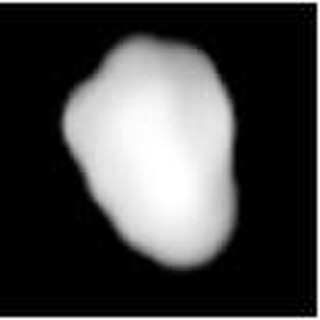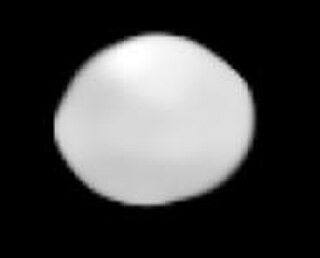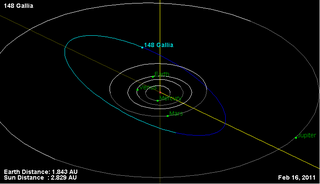Related Research Articles

Metis is one of the larger main-belt asteroids. It is composed of silicates and metallic nickel-iron, and may be the core remnant of a large asteroid that was destroyed by an ancient collision. Metis is estimated to contain just under half a percent of the total mass of the asteroid belt.

Massalia, minor planet designation 20 Massalia, is a stony asteroid and the parent body of the Massalia family located in the inner region of the asteroid belt, approximately 145 kilometers in diameter. Discovered by Italian astronomer Annibale de Gasparis on 19 September 1852, it was named for the French city of Marseille, from which the independent discover Jean Chacornac sighted it the following night.

Euphrosyne is a very young asteroid. It is one of the largest asteroids. It was discovered by James Ferguson on September 1, 1854, the first asteroid found from North America. It is named after Euphrosyne, one of the Charites in Greek mythology. In 2019 a small companion was discovered. It is the third-roundest known asteroid ; this is thought to be due to having re-accreted after being disrupted by a collision, and it is not close to hydrostatic equilibrium.

Gallia is an asteroid from the central regions of the asteroid belt, approximately 90 kilometers in diameter. It was discovered on 7 August 1875, by the French brothers Paul Henry and Prosper Henry at the Paris, but the credit for this discovery was given to Prosper. It was named after the Latin name for the country of France, Gaul. Based upon its spectrum, it is an unusual G-type asteroid (GU) and a stony S-type asteroid in the Tholen and SMASS classification, respectively.

Maria is a Main belt asteroid that was discovered by French astronomer Henri Joseph Perrotin on January 10, 1877. Its orbit was computed by Antonio Abetti, and the asteroid was named after his sister, Maria. This is the namesake of the Maria asteroid family; one of the first asteroid families to be identified by Japanese astronomer Kiyotsugu Hirayama in 1918.

Eucharis is a large, slowly rotating main-belt asteroid that was discovered by French astronomer Pablo Cottenot on February 2, 1878, from Marseille Observatory. It was his only asteroid discovery. This object was named after Eucharis, a nymph from the 17th-century novel Les Aventures de Télémaque.

Eos is a large main-belt asteroid that was discovered by Austrian astronomer Johann Palisa on January 18, 1882, in Vienna. In 1884, it was named after Eos, the Greek goddess of the dawn, to honour the opening of a new observatory that was hoped to bring about a new dawn for Viennese astronomy.

Regina is a typical, although fairly large, Main belt asteroid. It was discovered by Auguste Charlois on 3 August 1889 in Nice, France. The asteroid is a suspected interloper in the Eucharis asteroid family.

Ornamenta is a relatively large main-belt asteroid, measuring 118 km in diameter. It is classified as a C-type asteroid and is probably composed of carbonaceous material.
945 Barcelona is a minor planet orbiting the Sun in the Asteroid belt. It was discovered 3 February 1921 from Barcelona by the Catalan astronomer Josep Comas i Solà (1868–1937) and named for the city of Barcelona (Spain), the birthplace of the discoverer. It has an estimated diameter of 25.5 km.
686 Gersuind is a minor planet orbiting the Sun that was discovered by German astronomer August Kopff on 15 August 1909 from Heidelberg. It was named after a character in Gerhart Hauptmann's play Gersuind.
780 Armenia is a minor planet in the asteroid belt orbiting the Sun. It is named after the Kingdom of Armenia, now Armenia. This object is orbiting at a distance of 3.11 AU with an eccentricity of 0.097 and a period of 5.50 yr. The orbital plane is inclined at an angle of 19.1° to the plane of rotation. This asteroid spans a girth of ~94 km. The long rotation period of this asteroid necessitated light curve data from more than one latitude. The overlapping data provided a solution with a period of 19.891±0.002 h and a brightness amplitude of 0.18±0.03 in magnitude.
781 Kartvelia is a minor planet orbiting the Sun that was discovered by Russian astronomer Grigory Neujmin on January 25, 1914. Kartvelia comes from the historic name for the inhabitants of the nation of Georgia. This object is orbiting at a distance of 3.22 AU with an eccentricity (ovalness) of 0.12 and a period of 5.78 yr. The orbital plane is inclined at an angle of 19.1° to the plane of the ecliptic.
1101 Clematis is an Alauda asteroid from the outermost regions of the asteroid belt, approximately 37 kilometers in diameter. It was discovered on 22 September 1928, by German astronomer Karl Reinmuth at the Heidelberg-Königstuhl State Observatory in southwest Germany, and assigned the provisional designation 1928 SJ. It was named for the flowering plant Clematis. The presumably carbonaceous asteroid has a relatively long rotation period of 34.3 hours.
1372 Haremari, provisional designation 1935 QK, is a rare-type Watsonian asteroid and a suspected trojan of Ceres from the central regions of the asteroid belt, approximately 26 kilometers in diameter. It was discovered on 31 August 1935, by astronomer Karl Reinmuth at the Heidelberg-Königstuhl State Observatory in southwest Germany. The asteroid was named for all female staff members of the Astronomical Calculation Institute.
21509 Lucascavin, provisional designation 1998 KL35, is a small asteroid from the inner regions of the asteroid belt, approximately 2.5 kilometers (1.6 miles) in diameter. It is the namesake of the tiny Lucascavin family located within the Flora clan. It was discovered on 22 May 1998, by astronomers with the Lincoln Near-Earth Asteroid Research at the Lincoln Laboratory's Experimental Test Site near Socorro, New Mexico. The presumed S-type asteroid has a rotation period of 5.8 hours. It was named for the 2005-ISEF awardee Lucas James Cavin.
1222 Tina, provisional designation 1932 LA, is a metallic asteroid and parent body of the Tina family located in the intermediate asteroid belt, approximately 25 kilometers in diameter. It was discovered on 11 June 1932, by Belgian astronomer Eugène Delporte at Uccle Observatory in Belgium. It was named after a friend of the discoverer.
(11436) 1969 QR, is a stony Florian asteroid from the inner regions of the asteroid belt, approximately 3.7 kilometers in diameter. It was discovered on 22 August 1969, by Czech astronomer Luboš Kohoutek at Bergedorf Observatory in Hamburg, Germany.
21501 Acevedo, provisional designation 1998 KC8, is a stony Florian asteroid from the inner regions of the asteroid belt, approximately 2.4 kilometers in diameter.
(39546) 1992 DT5 is a dark Hoffmeister asteroid and exceptionally slow rotator from the central region of the asteroid belt, approximately 5.3 kilometers (3.3 miles) in diameter. The likely elongated C-type asteroid was discovered on 29 February 1992, by the Uppsala–ESO Survey of Asteroids and Comets at ESO's La Silla astronomical observatory site in northern Chile.
References
- ↑ "watsonia" . Oxford English Dictionary (Online ed.). Oxford University Press.(Subscription or participating institution membership required.)
- ↑ Yeomans, Donald K., "729 Watsonia", JPL Small-Body Database Browser, NASA Jet Propulsion Laboratory , retrieved 5 May 2016.
- ↑ Pier Paolo Ricci (29 November 2012), Almanacco astronomico 2013 Astronomical almanac 2013, Lulu.com, pp. 322–, ISBN 978-1-291-21157-3
- ↑ Novaković, Bojan; et al. (November 2011), "Families among high-inclination asteroids", Icarus, vol. 216, no. 1, pp. 69–81, arXiv: 1108.3740 , Bibcode:2011Icar..216...69N, doi:10.1016/j.icarus.2011.08.016.